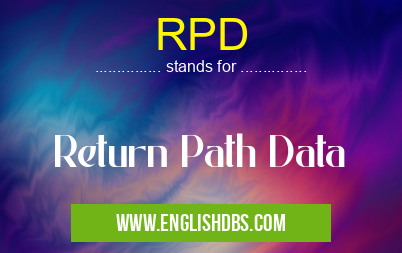What does RPD mean in UNCLASSIFIED
RPD stands for Return Path Data, which refers to information gathered about emails sent from a sender's domain to track their delivery status. This data provides insights into the effectiveness of email campaigns, identifying issues like bounces, spam filtering, and recipient engagement.

RPD meaning in Unclassified in Miscellaneous
RPD mostly used in an acronym Unclassified in Category Miscellaneous that means Return Path Data
Shorthand: RPD,
Full Form: Return Path Data
For more information of "Return Path Data", see the section below.
What is RPD?
RPD is collected by specialized software or services that monitor email traffic and provide detailed reports. It includes metrics such as:
- Delivery Rate: Percentage of emails successfully delivered to recipients' inboxes.
- Bounce Rate: Percentage of emails that could not be delivered due to errors or invalid addresses.
- Spam Rate: Percentage of emails caught by spam filters and not delivered to recipients' inboxes.
- Open Rate: Percentage of emails opened by recipients.
- Click-Through Rate: Percentage of recipients who clicked on links within the email.
Benefits of Using RPD
RPD offers several benefits for email marketers and businesses:
- Track Campaign Performance: Monitor the success of email campaigns and identify areas for improvement.
- Identify Delivery Issues: Diagnose bounce rates, spam filtering, and other delivery problems to improve email deliverability.
- Personalize Email Communication: Gain insights into recipient behavior and tailor email content based on their preferences.
- Improve Sender Reputation: Maintaining a positive delivery rate helps establish a sender's reputation and avoid being flagged as spam.
- Enhance Customer Engagement: Track engagement metrics to understand how recipients interact with emails and make adjustments accordingly.
Essential Questions and Answers on Return Path Data in "MISCELLANEOUS»UNFILED"
What is Return Path Data (RPD)?
Return Path Data is a set of information associated with an email message that provides insights into the success of email delivery. It includes details about the recipient's engagement, email client, and potential delivery issues.
Why is Return Path Data important?
RPD helps email marketers improve their email campaigns by providing valuable information, such as:
- Identifying email addresses that are invalid or undeliverable
- Tracking email open rates, click-through rates, and bounce rates
- Troubleshooting email delivery issues
- Enhancing email list quality and reducing spam complaints
How is RPD collected?
RPD is collected through various methods, including:
- Email headers, which contain information about the sender, recipient, and email routing
- Email service providers, which monitor email traffic and provide insights into email performance
- Third-party tracking tools, which analyze email campaigns and provide detailed RPD
What are the benefits of using RPD?
Using RPD offers numerous benefits, including:
- Improved email deliverability by identifying and resolving delivery issues
- Enhanced email engagement by understanding recipient behavior and preferences
- Increased ROI by optimizing email campaigns based on RPD insights
- Improved reputation management by reducing spam complaints and maintaining a positive sender reputation
How can I access Return Path Data?
RPD can be accessed through various channels, such as:
- Email service providers, which typically provide RPD dashboards or reports
- Third-party email analytics tools, which offer comprehensive RPD analysis
- Email marketing software, which may integrate with RPD platforms
Final Words: RPD is a valuable tool for email marketers and businesses to optimize their campaigns, improve deliverability, and enhance customer engagement. By collecting and analyzing RPD, organizations can gain insights into the effectiveness of their email communication and make data-driven decisions to improve their reach and impact.
RPD also stands for: |
|
| All stands for RPD |
